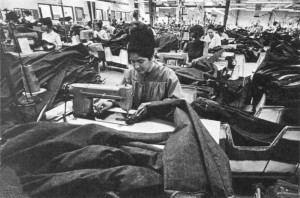Work & Class
On Long Island, New York, in the early 1990s, a new kind of organization started to organize workers that traditional unions largely neglected: undocumented immigrants. These day laborers, housecleaners, and workers at small factories sustained the Long Island economy – as they did so many communities throughout the United States – but had few organizations to turn to if they didn’t get paid, got hurt on the job, or suffered harassment from employers.
The Workplace Project organized workers to organize themselves by providing workshops on legal rights, worker health and safety, and strategizing. The Project’s methodology was new. Rather than starting with the assumption that participants had a problem, Workplace Project founder Jennifer Gordon explains, “the project began from the belief that the system had a problem, and that unenforced laws are just one symptom. The course encouraged workers to think about justice rather than legally codified rights, and to ask what a just workplace would look like and what strategies they might use to achieve it.”
With the workers in the lead, the Workplace Project scored a stunning series of victories, such as raising wages by 30 percent for day laborers and pursuing lawsuits and pickets that netted millions of dollars for aggrieved workers. It organized worker-owned coops for landscaping and housecleaning. The most dramatic victory came not from getting employers to observe the basic requirements for compensation and health and safety mandated by New York labor laws, but in changing the law. Immigrant workers lobbied the New York Senate and Assembly to pass a bill – co-sponsored by Republicans, passed unanimously, and signed into law by a Republican governor in 1997 – that steeply raised the penalties for employers who failed to pay minimum wage. It was the strongest wage enforcement law in the country at the time.
In the United States from 1983 to 2000, union membership fell from 20 percent of the workforce to only 13 percent (in the private sector, unionization has fallen below 10 percent). Globally, the International Labor Organization has noted a similar trend. Globalization has hampered union organizing since companies can pull up stakes and move to lower wage countries. Privatization has undercut public sector unions. Free trade zones, the gutting of enforcement mechanisms, and the decline of traditional trades have all reduced the power of organized labor. The changing nature of work, with the impact of computers, the Internet, and robotics, has also tested the capacity of traditional unions to represent labor.
On the other hand, unions have scored significant victories around the world, such as blocking the privatization of water companies in Ecuador and fighting structural adjustment policies in Argentina. And new types of worker organizations have emerged to represent immigrants, reach out to workers in new sectors, and address labor rights transnationally. Community-based worker organizing projects have sprung up throughout the United States, 118 such initiatives in 30 states. Organizing projects in new sectors — among immigrants, day laborers, janitorial staff, workers in fast food restaurants — are branching out. And new transnational initiatives, like Europe’s Clean Clothes Campaign and Canada’s Maquila Solidarity Network, have brought together consumers, labor unions, and nongovernmental organizations to put pressure on companies to observe health and safety regulations, pay workers a livable wage, and more generally raise the floor in terms of standards.
At a time when the neoliberal project, with its reduction of government influence on the economy and its increase of flexibility for capital, has wormed its way into the political platforms of many governments around the world, class-based appeals either in traditional union organizing drives or in the new community-based structures continue to generate considerable resistance. Though unions may be on the decline, the power of labor finds ever new expressions.
Has globalization pulled the rug out from under trade unions in such a way that they will never recover? Have unions failed to capitalize on the anti-globalization movement? Is the trade union model – and the tripartite approach of such organizations as the International Labour Organization – increasingly archaic? Can class-based appeals compete with religious and nationalist agendas, either in the global south or in post-industrial countries? Is more and more education the solution for workers thrown out of work by capital shifting overseas? How can union organizations in the north and south construct meaningful solidarity when the global marketplace pits their interests against one another? How can environmental activists and those arguing for stricter health and safety regulations prevent corporations from abandoning any given location for areas with fewer restrictions?
On a trip to Provisions, you can read the words of the great organizer of farmworkers in The Words of Cesar Chavez, compare the coverage of unions in In These Times and New Politics, go online to see the Smithsonian’s exhibit on sweatshops, view the stunning photographs in Sebastiao Salgado’s Workers: An Archaeology of the Industrial Age, listen to the tribute to Joe Hill on the album Don’t Mourn, Organize, and see the classic union film Salt of the Earth that left so many of its crew on the Hollywood black list.


